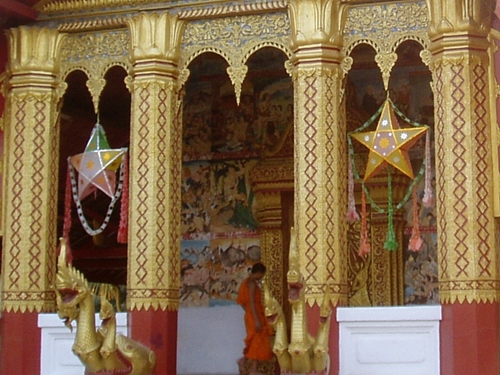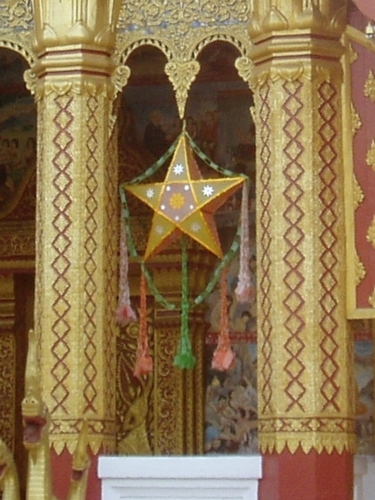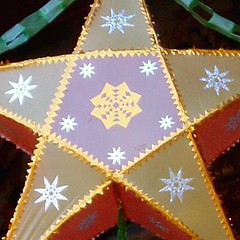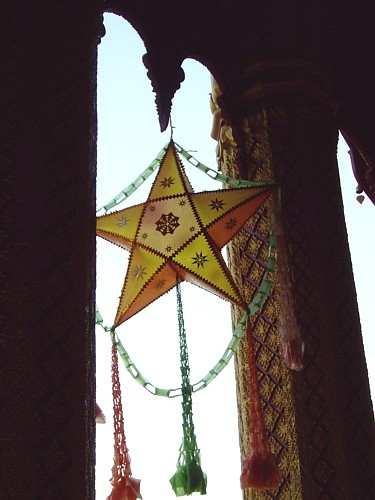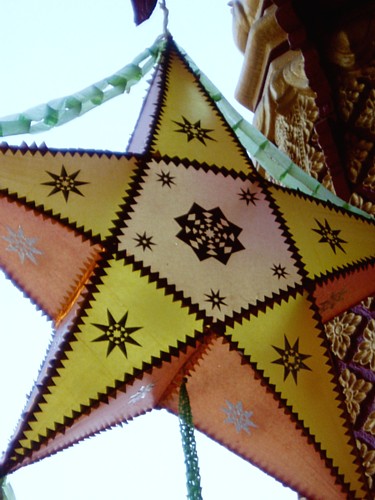An interruption of normal programming...
As the wait for foreign aid to trickle in drags on, overseas Burmese are raising funds to support the efforts of their countrymen in Burma who are obtaining relief supplies locally & distributing them directly to areas hit by Cyclone Nargis. As Burmese they are able to access affected areas that remain sealed off to foreign aid workers.
For more background information, updates & photos, please see:
Cyclone-aid.blogspot.com
For details on how to contribute, kindly contact any of the email addresses listed in the blog.
Another similar effort at:
Cyclonerelief.wordpress.com.
Other links:
ReliefWeb - Myanmar
ReliefWeb - maps
mercyrelief.blogspot.com
Thursday, May 15, 2008
Saturday, May 10, 2008
Sunday, May 04, 2008
261206 Wat Hosieng - 03
ใบเสมา bai sema (also spelt ใบสีมา) with a wheel of Dhamma design, one of eight surrounding the bot that demarcates the consecrated area where religious ceremonies like ordinations take place:
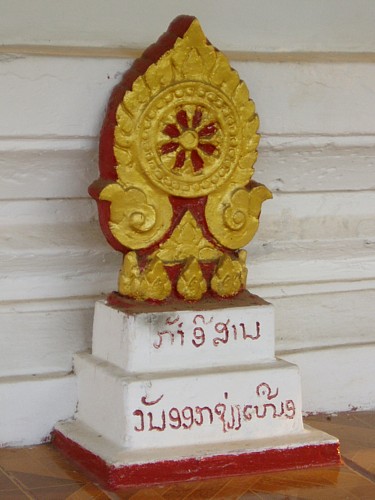
They mark the location of spherical stones called ลูกนิมิต luuk nimit that lie buried beneath. A ninth one lies buried under the middle of the consecrated area. For some reason, the luuk nimit of Wat Phrathat Choengchum in Sakon Nakhon, Thailand (where a 'Lao consultant' now lives), remain above ground.
On an exterior wall of the bot, paintings tell the story of a ຫອຍສັງ hoi sang (conch shell) released to earth by Pha In (Indra):

Guess the artist from a landlocked country had never seen a real conch shell before, & drew it more like a snail shell, which unfortunately looks almost exactly like how turd is illustrated in the ขายหัวเราะ Khai Hua Ror Thai cartoon books that the cat used to 'read' as a kid. This painting didn't help at all:
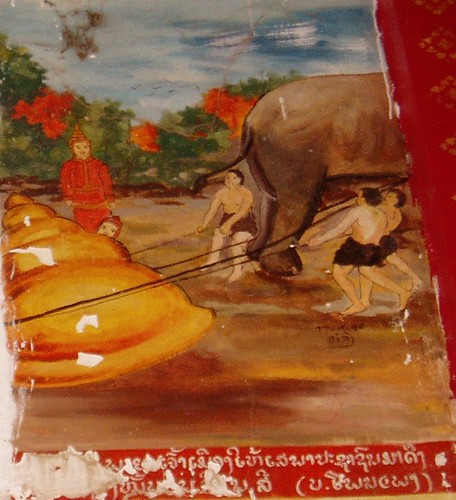
The elephant butt really made the cat think the men & pachyderm were trying to haul a giant piece of golden elephant pie. Much of the captions had flaked off, so the 'Lao consultants' themselves couldn't recall the entire story nor the name of the protagonist. According to one of them, there's something about the king wanting the conch shell to be brought to him, but no one could make it budge an inch, not even an elephant. A poor orphan boy (plenty of Lao folktales seem to involve poor orphan boys) who learnt from his grandmother the secret of making it move was able to do so using 'black & red thread', & much further into the story a pretty girl or princess emerged from within the conch shell & lived happily ever after with the orphan or something to that effect. The 'consultant' who related these parts of the story is an orphan from a poor family himself, perhaps that's his dream too ;)
Dok jampa (frangipani), the national flower of Laos:
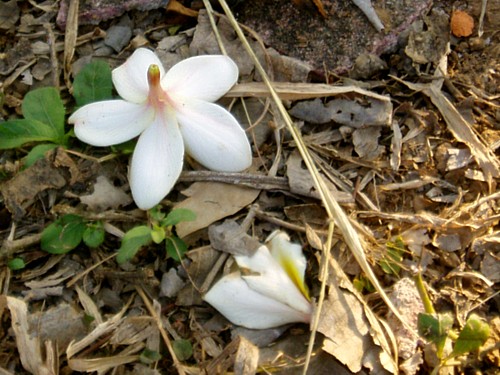
Offerings at the feet of Mae Thoranii:
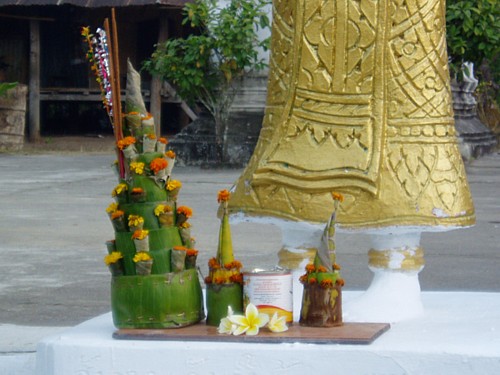

They mark the location of spherical stones called ลูกนิมิต luuk nimit that lie buried beneath. A ninth one lies buried under the middle of the consecrated area. For some reason, the luuk nimit of Wat Phrathat Choengchum in Sakon Nakhon, Thailand (where a 'Lao consultant' now lives), remain above ground.
On an exterior wall of the bot, paintings tell the story of a ຫອຍສັງ hoi sang (conch shell) released to earth by Pha In (Indra):

Guess the artist from a landlocked country had never seen a real conch shell before, & drew it more like a snail shell, which unfortunately looks almost exactly like how turd is illustrated in the ขายหัวเราะ Khai Hua Ror Thai cartoon books that the cat used to 'read' as a kid. This painting didn't help at all:

The elephant butt really made the cat think the men & pachyderm were trying to haul a giant piece of golden elephant pie. Much of the captions had flaked off, so the 'Lao consultants' themselves couldn't recall the entire story nor the name of the protagonist. According to one of them, there's something about the king wanting the conch shell to be brought to him, but no one could make it budge an inch, not even an elephant. A poor orphan boy (plenty of Lao folktales seem to involve poor orphan boys) who learnt from his grandmother the secret of making it move was able to do so using 'black & red thread', & much further into the story a pretty girl or princess emerged from within the conch shell & lived happily ever after with the orphan or something to that effect. The 'consultant' who related these parts of the story is an orphan from a poor family himself, perhaps that's his dream too ;)
Dok jampa (frangipani), the national flower of Laos:

Offerings at the feet of Mae Thoranii:

261206 Wat Hosieng - 02
Eleven-spired ຍອດຊໍ່ຟ້າ yot sor faa on the roof ridge, with hongsa that look like roadrunners:
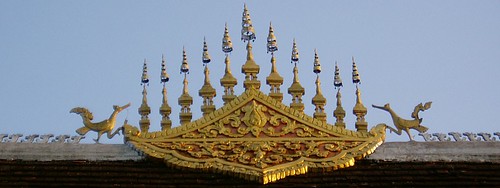
Doors of the ໂບດ bot...
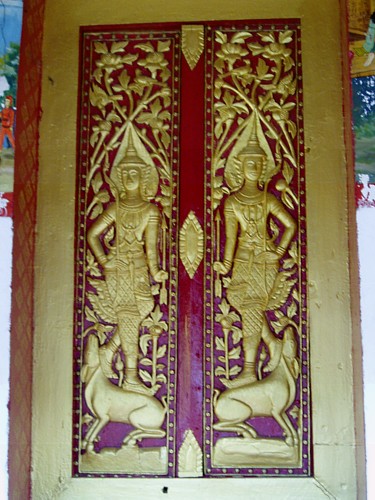
...which has a verandah on either side:
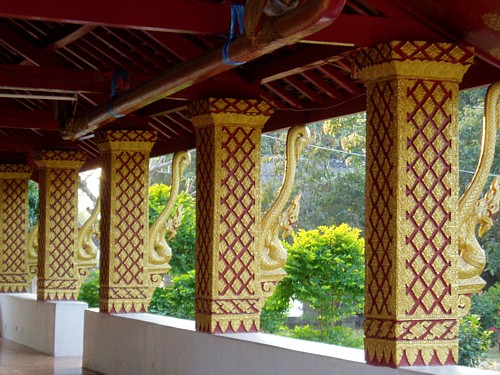
Detail of pillar:

Tied to the rafters of the verandah is the long naga-shaped wooden ຣາງລິນ haanglin (trough) used for pouring water onto Buddha statues to cleanse them during Lao New Year celebrations:
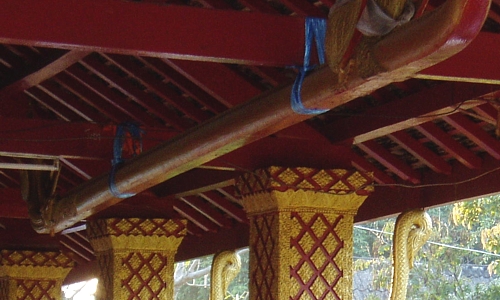
People will pour water into the tail end & the water will drip from the mouth end onto Buddha statues placed beneath. Not sure how or why the use of this trough came about, but it's a good way to avoid having people tower directly & not exactly respectfully over the heads of the Buddha statues. A better photo of it here.
Eave brackets:
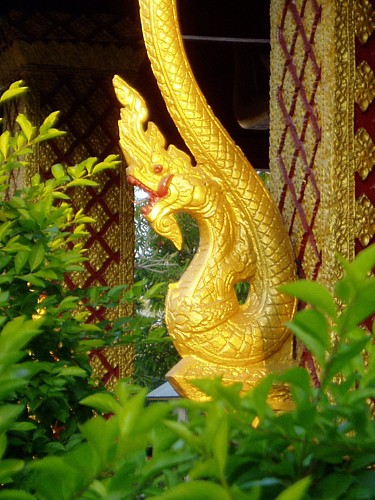
This is one of the very few places where the cat has seen naga with bloodshot eyes & their mouths painted menacingly red...hopefully cat meat isn't part of their diet.

Doors of the ໂບດ bot...

...which has a verandah on either side:

Detail of pillar:

Tied to the rafters of the verandah is the long naga-shaped wooden ຣາງລິນ haanglin (trough) used for pouring water onto Buddha statues to cleanse them during Lao New Year celebrations:

People will pour water into the tail end & the water will drip from the mouth end onto Buddha statues placed beneath. Not sure how or why the use of this trough came about, but it's a good way to avoid having people tower directly & not exactly respectfully over the heads of the Buddha statues. A better photo of it here.
Eave brackets:

This is one of the very few places where the cat has seen naga with bloodshot eyes & their mouths painted menacingly red...hopefully cat meat isn't part of their diet.
261206 Wat Hosieng - 01
Omitted from most travel guidebooks, websites & maps, & partially hidden by large trees & its raised location above street level. Quite a few of the few tourists who discover Wat Hosieng label their photos of it as Wat Mahathat, probably because most sources of tourist info indicate the latter as the sole temple in the vicinity.
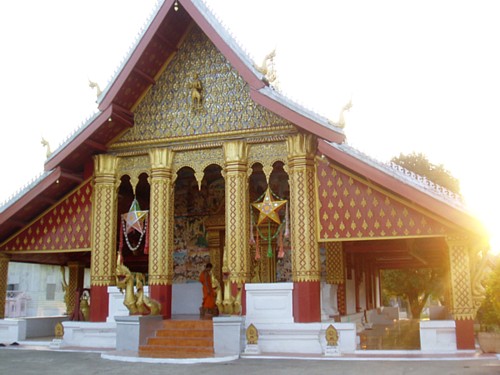
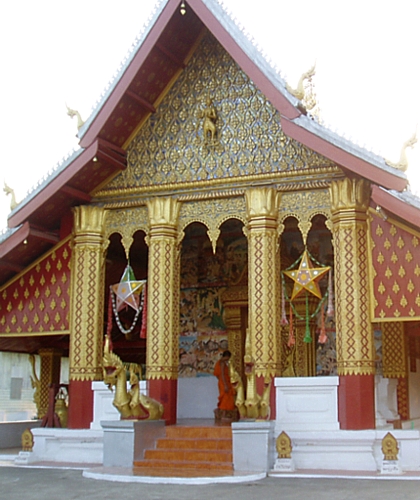
3-D Pha Ram (Rama) on the tympanum of the pediment/gable (much better quality photo here), looking like an ancient Lao version of a toy action figure:
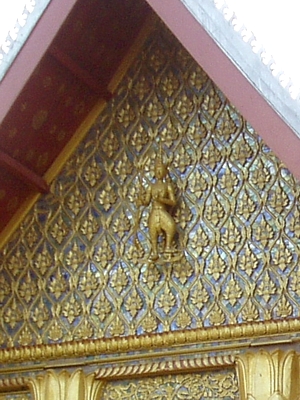
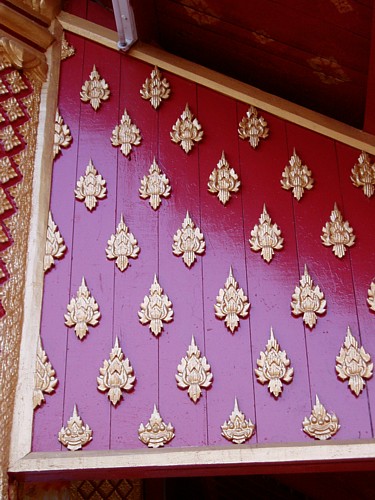
Bottom row looks like a series of Rahu or Kala faces:
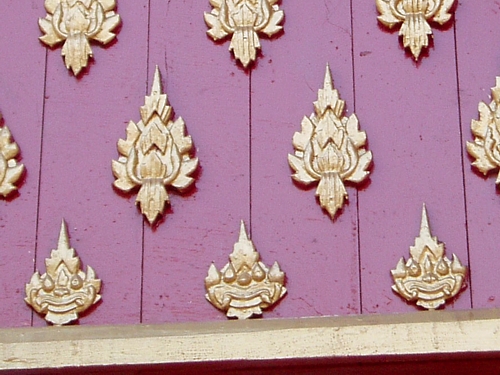
On both sides of the steps leading up to the portico, naga that are either bloodthirsty or addicted to chewing betel nut (hence the red mouth & teeth) emerge from the mouth of a makara:
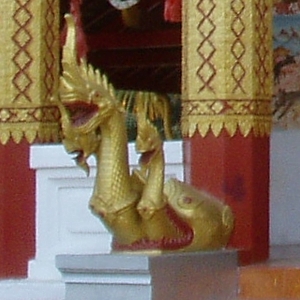
Like naga, makara are aquatic creatures that are the mount of the Hindu goddess Ganga & god Varuna. Does anyone out there know why naga emerge from the mouth of makara? This is also seen on the main stairs at the Chao Fa Ngum Road side of the temple.


3-D Pha Ram (Rama) on the tympanum of the pediment/gable (much better quality photo here), looking like an ancient Lao version of a toy action figure:


Bottom row looks like a series of Rahu or Kala faces:

On both sides of the steps leading up to the portico, naga that are either bloodthirsty or addicted to chewing betel nut (hence the red mouth & teeth) emerge from the mouth of a makara:

Like naga, makara are aquatic creatures that are the mount of the Hindu goddess Ganga & god Varuna. Does anyone out there know why naga emerge from the mouth of makara? This is also seen on the main stairs at the Chao Fa Ngum Road side of the temple.
261206 Wat Mahathat miscellaneous
Tham alphabet soup on the alarm clock:

The cat first came across this alphabet when a novice monk in Phayao gave it several bookmarks with a quote from a famous monk written in Tham script, with an accompanying Thai-glish translation:
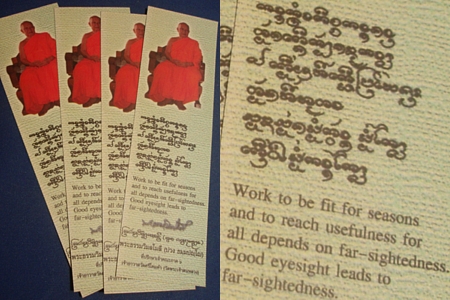
In this case people in Singapore (& Taiwan & Hong Kong) should be really crap at longterm planning since the country has one of the highest prevalence of myopia in the world (28% of 7 y/o kids & >80% of 18 y/o teens are shortsighted). A lot more detail on Tham script here.
A lotus bud(?) that looks more like a golden artichoke to the cat's myopic eyes:
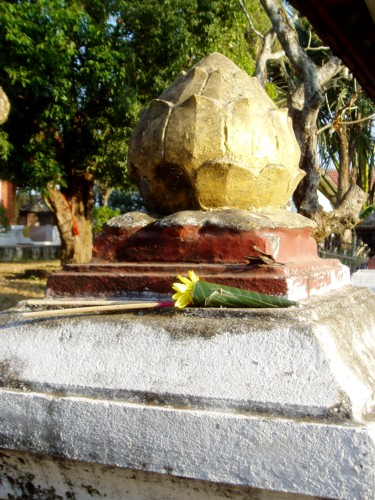
With the Lao version of temaki sushi (using banana leaf in place of seaweed) at the base:
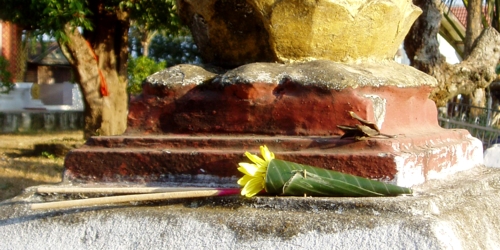

Lao version of columbaria:
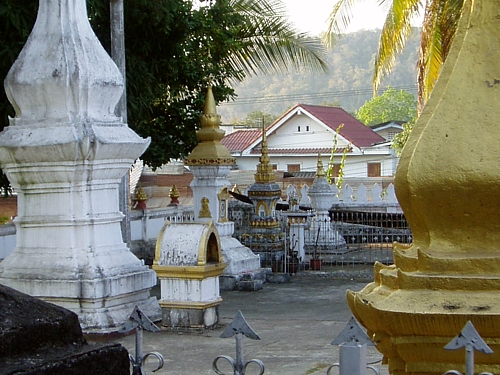
Such mini stupas housing ashes of the deceased are incorporated into the boundary walls of many temples in Vientiane capital, like this (Wat Nongbone) & this (Wat That Luang Tai). Here in Luang Prabang, almost all of them are inside of & separate from the boundary walls.

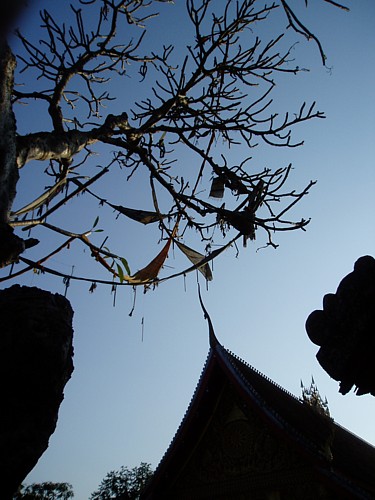

The cat first came across this alphabet when a novice monk in Phayao gave it several bookmarks with a quote from a famous monk written in Tham script, with an accompanying Thai-glish translation:

In this case people in Singapore (& Taiwan & Hong Kong) should be really crap at longterm planning since the country has one of the highest prevalence of myopia in the world (28% of 7 y/o kids & >80% of 18 y/o teens are shortsighted). A lot more detail on Tham script here.
A lotus bud(?) that looks more like a golden artichoke to the cat's myopic eyes:

With the Lao version of temaki sushi (using banana leaf in place of seaweed) at the base:


Lao version of columbaria:

Such mini stupas housing ashes of the deceased are incorporated into the boundary walls of many temples in Vientiane capital, like this (Wat Nongbone) & this (Wat That Luang Tai). Here in Luang Prabang, almost all of them are inside of & separate from the boundary walls.


Friday, May 02, 2008
261206 Wat Mahathat - banner
A yellow ທຸງ (thoung, aka. ตุง dtung in Lanna Thai) on the grounds of Wat Mahathat:
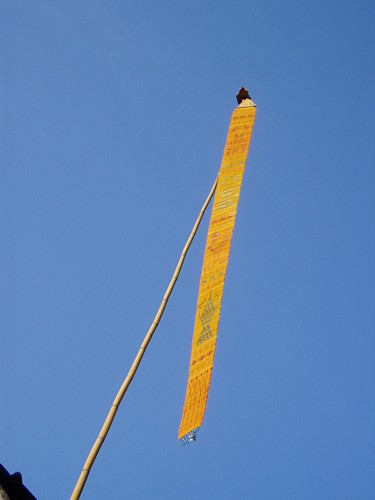
Much like some of those that the cat saw hanging from the ceiling of Wat Sing Jai, a Tai Lue temple in Muang Sing, & at another temple (upper left) in Chiang Khong, & some other places in Chiangrai.
Tai Lue (ไทลื้อ), Tai Yai & some other Tai ethnic groups weave such banners as offerings for the Buddha, to make merit for one's future life, as offerings for ancestors, & on occasions like ordinations, the completion of a new temple building, & funerals. The cat has been told that in parts of North Thailand, red coloured ones are planted at sites of 'dtaai hohng' (ตายโหง unnatural or violent death) e.g. site of fatal accident along a road, to help the deceased to be reborn again. Without them the spirit will remain behind until another victim comes to take his/her place. The cat has not seen such examples before, but imagines that they must be placed like the white wooden crosses it has seen along highways in Australia & other Western countries.
There are motifs like hongsa, elephants, horses, naga, diamond shapes, thaat (stupa), castle-like structures that represent heavenly abodes, structures that look like this, & other stuff that the cat cannot figure out, like this (click to zoom in on amazing detail), this & this:
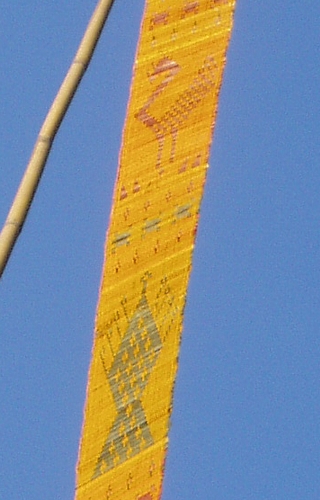
Thin strips of bamboo are used to stiffen the banners, which are like ladders to help souls of the deceased climb from hell up into heaven. In the laomeow consultants' Tai Lue village, villagers make rockets (a la Boun Bangfai, the rainmaking 'rocket festival') to go with such banners during funerals. Presumably one needs a hole in the sky in order to ascend to heaven?
Traditionally these banners are woven from cotton, & may be decorated with tassels, little pompoms, paper flowers, or even membranaceous winged seeds (from some pterocarp species?) & banknotes tied to them along the fringes. Tai Lue are known for their signature black+red+white versions, a colour combination used for their pha chet luang (shoulder scarf), blankets, bedsheets, coffin covers, shoulder bags, & other textiles as well. Now modern 'shortcut' versions (Tai Yai example from Chiangrai) are made by cutting long strips of cloth or even lace, no weaving required.
Some banners are made with 16 sections to represent the '16 levels of heaven'...think this refers to the 16 'realms of form' (rupaloka), part of the 31 planes of existence in Buddhist cosmology. In some parts of Thailand, a short banner with three 'tails' called thoung saam haang (ตุงสามหาง lit. banner three tails) is used in funeral processions.
No matter how long a bamboo pole you use, no matter how high you raise it in the sky...what makes you think you can ever hide a fish from a cat?
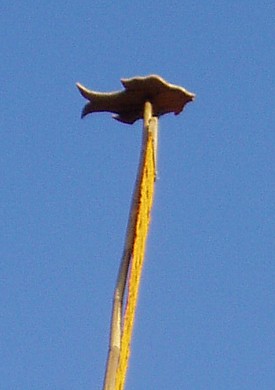
Anyone who knows if the fish at the top of the pole of the banner has any special meaning, please enlighten the cat. Some links for those who would like to find out more about 'thoung' (mostly Thai-only websites):
area.obec.go.th/phayao1/upa/Gong.htm (TH)
www.stjohn.ac.th/Department/info/tung.html (TH)
lanna.mju.ac.th/lannaequipments_detail.php?recordID=36 (TH)
www.thaitextilemuseum.com/English/Variety/tung.pdf (EN)
Textiles of Southeast Asia: Tradition, Trade & Transformation on Google Books (EN)
cultural.payap.ac.th/story/N8BWra1Sat23057.pdf (TH)

Much like some of those that the cat saw hanging from the ceiling of Wat Sing Jai, a Tai Lue temple in Muang Sing, & at another temple (upper left) in Chiang Khong, & some other places in Chiangrai.
Tai Lue (ไทลื้อ), Tai Yai & some other Tai ethnic groups weave such banners as offerings for the Buddha, to make merit for one's future life, as offerings for ancestors, & on occasions like ordinations, the completion of a new temple building, & funerals. The cat has been told that in parts of North Thailand, red coloured ones are planted at sites of 'dtaai hohng' (ตายโหง unnatural or violent death) e.g. site of fatal accident along a road, to help the deceased to be reborn again. Without them the spirit will remain behind until another victim comes to take his/her place. The cat has not seen such examples before, but imagines that they must be placed like the white wooden crosses it has seen along highways in Australia & other Western countries.
There are motifs like hongsa, elephants, horses, naga, diamond shapes, thaat (stupa), castle-like structures that represent heavenly abodes, structures that look like this, & other stuff that the cat cannot figure out, like this (click to zoom in on amazing detail), this & this:

Thin strips of bamboo are used to stiffen the banners, which are like ladders to help souls of the deceased climb from hell up into heaven. In the laomeow consultants' Tai Lue village, villagers make rockets (a la Boun Bangfai, the rainmaking 'rocket festival') to go with such banners during funerals. Presumably one needs a hole in the sky in order to ascend to heaven?
Traditionally these banners are woven from cotton, & may be decorated with tassels, little pompoms, paper flowers, or even membranaceous winged seeds (from some pterocarp species?) & banknotes tied to them along the fringes. Tai Lue are known for their signature black+red+white versions, a colour combination used for their pha chet luang (shoulder scarf), blankets, bedsheets, coffin covers, shoulder bags, & other textiles as well. Now modern 'shortcut' versions (Tai Yai example from Chiangrai) are made by cutting long strips of cloth or even lace, no weaving required.
Some banners are made with 16 sections to represent the '16 levels of heaven'...think this refers to the 16 'realms of form' (rupaloka), part of the 31 planes of existence in Buddhist cosmology. In some parts of Thailand, a short banner with three 'tails' called thoung saam haang (ตุงสามหาง lit. banner three tails) is used in funeral processions.
No matter how long a bamboo pole you use, no matter how high you raise it in the sky...what makes you think you can ever hide a fish from a cat?

Anyone who knows if the fish at the top of the pole of the banner has any special meaning, please enlighten the cat. Some links for those who would like to find out more about 'thoung' (mostly Thai-only websites):
area.obec.go.th/phayao1/upa/Gong.htm (TH)
www.stjohn.ac.th/Department/info/tung.html (TH)
lanna.mju.ac.th/lannaequipments_detail.php?recordID=36 (TH)
www.thaitextilemuseum.com/English/Variety/tung.pdf (EN)
Textiles of Southeast Asia: Tradition, Trade & Transformation on Google Books (EN)
cultural.payap.ac.th/story/N8BWra1Sat23057.pdf (TH)


